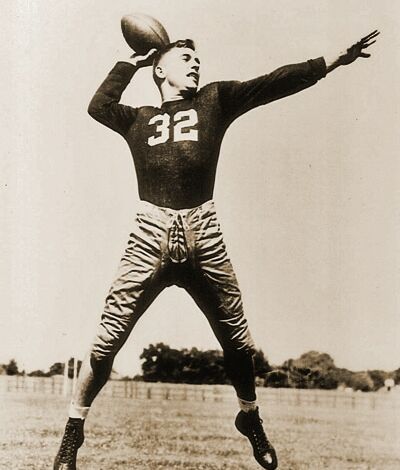
John Lujack was born and raised in Connellsville, Pennsylvania, southeast of Pittsburgh. Lujack was a four sport athlete at Connellsville, and was an RKG, graduating as both the Valedictorian and Senior Class President of Connellsville ’42.
He was a “phenom” on and off the field, and the local gentry, a few months after Pearl Harbor, encouraged him to attend West Point. But young Johnny had spend Saturday Autumn afternoons glued to his radio listening to the exploits of a civilian team, the University of Notre Dame.
When Lujack arrived, he was soon the backup to Angelo Bertelli, and in the kind of thing that only happens in South Bend, under the Golden Dome, Lujack took over when Bertelli departed, mid-Heisman trophy season in 1943, to join the Marines. Lujack, never lacking in confidence, helped the irish finish out a national championship season in 1943. Lujack also found time to play basketball for Coach George Keoghan and the Irish hoopers.
Lujack, like Bertelli, his coach Leahy and many other Irish of the era, did not shrink from duty’s call, and spent the ’44 and ’45 seasons not on Cartier, but in the Navy. He had no “show” tour and performed as an ensign hunting Nazi submarines in the English Channel.
Then he returned to south Bend in 1946 with the greatest recruiting class in the grand and glorious history of college football. Players like Lujack who interrupted their Notre Dame career for service to country, augmented by other vets that Leahy was actively recruiting all joined a stellar group of freshman who had just finished high school, eager to labor for the returning Leahy.
At Notre Dame, comparisons are invidious. And the decades are filled with great leaders of Notre Dame teams. But it is arguable that Lujack, a natural leader whose skills and confidence only increased during his service, may have been the greatest on field leader ever for a Notre Dame team. “Field General.” That he was. And he was ready to lead the juggernaut 1946 Notre Dame team.
A post-war America could relax and focus on sports, and as soon as the 1946 season opened, two teams rose above the rest: Army and Notre Dame.
But before we get there let’s review one off field anecdote about Leahy and Lujack in 1946. Leahy, never one to let a crisis go unexploited, was fearful about his team’s focus as they headed to Iowa City for the season’s fourth game. At that point the Irish had outscored foes Illinois, Pitt and Purdue by a combined 108-12. Leahy took the entire team to the cemetery to pray to Rockne (the theological legitimacy of this is beyond the scope of this post!) for help on the way out to Iowa City. This was a quintessential Leahy moment filled with loyalty, pathos, drama, nostalgia and a whiff of spirituality.
Entombed in the same cemetery was George Keoghan, the former Notre Dame basketball coach who died in 1943. Lujack, the multi-sport star, had played basketball under Keoghan. As Lujack drifted over to say a few prayers at Keoghan’s gravestone, Leahy became incensed.
“John Lujack, what are you doing over at George Keoghan’s grave rather than being here with your team at Rock’s gravesite.” “Just saying a few prayers, Coach,” Lujack said. “PRAY TO KEOGHAN DURING BASKETBALL SEASON!!” Ah, Leahy, he never lost focus!!
By the way, the Irish hammered the Hawkeyes in Kinnick Stadium 41-6.
Again, in a tradition initiated by Knute Rockne, the Irish would travel to the Bronx to play the Cadets in Yankee Stadium on November 9, 1946. It was, to that point, the most anticipated college football game of all time, later rivaled by the two month long buildup for the Michigan State-Notre Dame game of 1966.
The New York Sporting press only added gasoline to the pre-game fire. Theyy had plenty of material to work with. Red Blaik and Frank Leahy. War heroes and Football heroes. Mr. Outside and Mr. Inside. All in New Yawk!
As the teams warmed up, four (eventual) Heisman trophy winners were on the field. 1945 winner Doc Blanchard, Blaik’s “Mr Inside,” 1946 winner Glenn Davis, Blaik’s “Mr. Outside,” 1947 winner Johnny Lujack and 1949 winner Leon Hart.
Football was different then, purer, more innocent. Players played both ways for the most part. So while Lujack was the quarterback he also played safety.
John Lujack’s Heisman Moment
In what would be a scoreless tie, the biggest play of the game was a defensive one. “Great players make big plays in big games.” So sayeth the conventional wisdom.
In the third quarter, on a day when the stout Irish defenders would hold the Heisman twins, Blanchard and Davis,
to 79 total yards, Army was marching from its own 44. The long gray line sprung Blanchard free and the tense crowd of 74,000 rose as one. Army fans cheered lustily to urge Blanchard into the end zone; Irish subway loyalists gasped and prayed for a heroic defensive play. Time, and college football, seemed to stop.
But Lujack who had tracked down Nazi subs, honed in on Blanchard and tackled him in the open field after a 20 yard gain, saving the touchdown and the tie. Reasonable minds may differ, but Lujack’s defensive play may have been, to that point in the 78 years of colege football, the greatest and most important play in the game’s history. And it punctuated Lujack’s versatility and excellence.
The Irish finished the season unbeaten and were voted the national champions.
Glenn Davis, Army’s “Mr. Outside” won the Heisman Trophy by a wide margin over Georgia’s Charley Trippi. John Lujack finished a strong third, positioning himself for the 1947 Heisman race.
The 1947 Notre Dame Fighting Irish
There are many students of Notre Dame football who believe that the 1947 Irish National Champions were the greatest Notre Dame team ever. And in their mind that makes the 1947 Notre Dame team the greatest college football team ever.
Lujack was one of six College Football Hall of Famers on the ’47 team, joined by Leon Hart, Bill Fischer, George Connor, Emil Sitko and the irrepressible Ziggy Czarobski. Only Northwestern came within seven points of the Irish.
Lujack was the team leader, field general of the offense and last line of defense. His leadership, achievements and results were spectacular, his statistics less so. Lujack would later set the NFL passing yards record as a Bear with 468 passing yards against the South Side’s Chicago Cardinals. But Lujack was surrounded by a great roster at Notre Dame, and was a modest, controlled 61 of 109 for 777 yards and nine touchdowns in 1947.
Leahy deferred most of the running to Emil “Six Yard” Sitko, Terry Brennan and Bob Livingstone. Lujack ran tactically for 139 yards in a 12 carries, a tidy 11 yards per carry.
Bob Chappuis had a great year at Michigan and finished as runner up to Lujack in the Heisman Race. For good measure, Lujack, the best player on the best team, was also named the Associated Press Athlete of the Year for 1947.
Notre Dame had its second Heisman Trophy Winner, and the collection was just beginning.
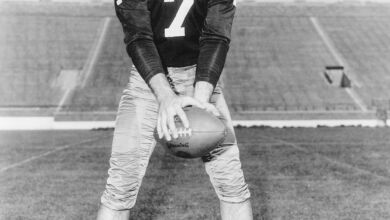
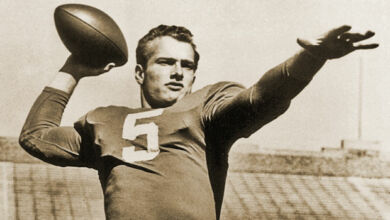
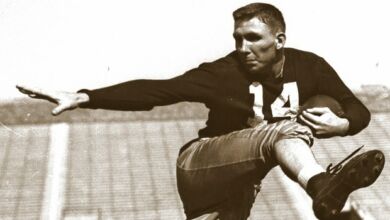
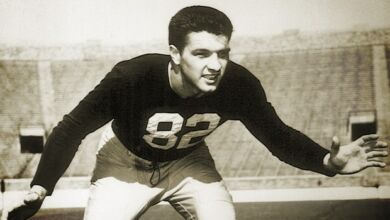
9.14.19 What a wonderful memory for my Mom. As she is watching the ND/ New Mexico Sat. afternoon game – she calls to tell me she remembers Johnny Lujack being the Hiesman trophy winnner in 1947. My Mom, Sheila Ratcliff, is 93 yrs. old and Johnny is 94. Would love for them to share memories of their past sports events and excitements. Sheila’s son – my brother- T. Patrick Ratcliff – graduated from ND in 1974. We have been to numerous games over the years – sitting on the 50 yard line. Love the spirit and camaraderie of the ND campus.
Please text or contact me if you would like a follow up. Mom is delaying Sat. Mass to watch the final portion of the game. Will go to Sunday Mass.
Mom lives in southeast Texas – but spent her childhood years in Detroit and Flint, Michigan. Mom would love to hear from you.
Go ND!
When Lujack was at ND& played Iowa, they stayed at the Blackhawks Hotel in Davenport, went to Mass at St. Anthony’s near the hotel, then walked a half block up the street & took the Rock Island Rocket to Iowa City. I was fortunate to serve Mass 2 of those years & would rip off my cassock after Mass & race around in front of church & get autographs. I still have them , including J.L ‘ s and several more of those great stars. Later in life I worked for a Bank that bought most of his dealership’s auto contracts and became well acquainted with J. Was & is still a great man.
I listened to Notre Dame football on the radio before we had TV. I think my memory is correct when I recall Johnny Lujack’s last game in 1947. On the last play the opponents heaved a long pass to make the score a little more respectable. Coach Leahy had the seniors in the game. Johnny Lujack intercepted the pass and rather than score he lateraled the pass to a teammate to take it in. The teammate wanted ever so much to score a touchdown but didn’t get to during his carrer at ND. Now his opportunity was at hand and he headed for the goal line. Alas! The lad tripped and fell before he reached the goal line. Does anyone recall who name of this lad?
I have the film of the 46 team and on many plays they knocked down everyone on the field. The linemen would take out their man and go looking for a LB or DB. Playing sandlot football as a kid I always pretended to be Johnny Lujack.
I am a 1965 ND grad, have followed ND football all of my life and think Lujack is the University’s greatest player, because of the success of the teams during the years that he played and for his ability to play on defense as well. Is there any more important play ever for a defensive player than the Lujack’s open-field tackle of Blanchard in 1946?
archangel, the series is continuing. We still have in the Notre Dame fan community people who experienced the ’46-’49 dynasty and Leahy’s Lads,
an alumni group like no other. They are the keepers of the flame.
Each of the seven stories has some twists and turns.
Gidday Geoffrey, I live in Kinglake West on the mountain. Dwight D. Eisenhower High School class of 65′ and ND fan since the Oklahoma win that broke their 47 game streak in the 50’s.Survived Black Saturday in 09′. If you google up Dale Platek Black Saturday from Melb. Age you can read about our family on that day and see photo of me and the family. Get in touch and we can talk all things Irish for hours if that appeals to you. Cheers
Pretty well covers it Sad Warrior. Can’t improve on this my man. Hoorah and Go Irish.
D-Train 65,we thank you for your comment. You get the point where others seem confused. An example would be this Blake Barnett scenario. Who would really want him if he was so quickly swayed to another camp? Sure, we would want him guarding our six,yeah right?! Hopefully Coach Saban will mold him into a fine QB for the Tide.
Without being too intrusive, we wonder about the origin of your call sign, D-Train 65? Some conjure up a 350 lb. lineman stomping down a `pint sized’ 250 lb. running back!
Take care of yourself and Stay Safe. hooah! Go Irish.
END EAM. OUT.
Gidday Sad Warrior, Re: my call sign was given to me by one of the many kids I have coached over 45 years of bball, baseball, and Australian Rules Football. Originally from Chi-town but been in Oz since 72′ I am only 225 and 6’5 but my dad was 290 and 6’3 and saw some “serious action” in the Marines at Guadalcanal in the Big Show with some of these ND boys. I was never called for Nam etc due to an arm I cannot straighten after 6 operations from an old baseball pitching injury. Always “appreciative” of what others have done to give us all the opportunity to live free from Tyranny both then and now. Irish future in good hands with guys like you “on watch”. Big shout out to you and the boys and you make sure you get home soon to South Bend to see the resurgence IN PERSON of Everett and the boys. Take care stay safe I’m sure my Dad and Lujack are looking down and proud of guys like you. Cheers mate Hooah from The D-Train.
D-Train, we thank you for your comments. Keeps everybody in better spirits here. They are heartily appreciated by all of us.
That’s quite a coaching resume you have put together! Some of us would like to be coaches some day down the way. We are now but of a different nature and outcome.
Your Pop sounded like a wrecking ball! You should be very proud of his service and duty to our country.
Hopefully some of us will be able to be back to get to a game wherever it is. You won’t see us but you will know we are there. We like to think that your Dad and Heisman Lujack are indeed looking not just down but over us as well. Angels on our shoulders.
Take care. Stay Safe. Love your country. Go Irish! Hooah!
Where are you in Oz? I am in Melbourne, class of 1973
Archangel, we have taken notice that a major difference, if not the premier difference, in the players of then and now were their sacrifices and service to this nation. Something more important than themselves and huge financial rewards were placed first. Whether they were Army, Marines, Navy, or Air Corp, they answered the cry for help without pause risking all to defeat the evils facing the world at that time. Many paid the final price, but that cry for help was answered and silenced. The Lujack’s and Bertelli’s were the foundation upon which greatness was/is forged. You do not see that very often today. Pat Tilman was a rare example, and trust us, he was a rare individual indeed. That is why football will always be a game that we cherish.
Go Irish! Stay Safe. Hooah!
Bob Murphy, class of ’49, still alive and well, came to ND from WWII.
He didn’t play football there, but has many stories of those unparalleled years during his four years
when, as a student, he never experienced ND losing a game (albeit they tied two).
Even though many at ND during those years were older than today’s ND student, Bob was always amazed
at the size of Lujack’s teammate and fellow Heisman winner (if I recall correctly) Leon Hart from that era.
Thanks, duranko, for keeping those priceless memories and moments with Bertelli, Lujack,
and. hopefully, more to come.
I WAS AT ND WHEN THEY NEVER LOST A GAME -1946 TO 1950. Lujack also played varsity basketball, as did George Ratterman who was great in both sports. He preceded Tripucka as Lujack’s backup. Those were great years to be at ND.